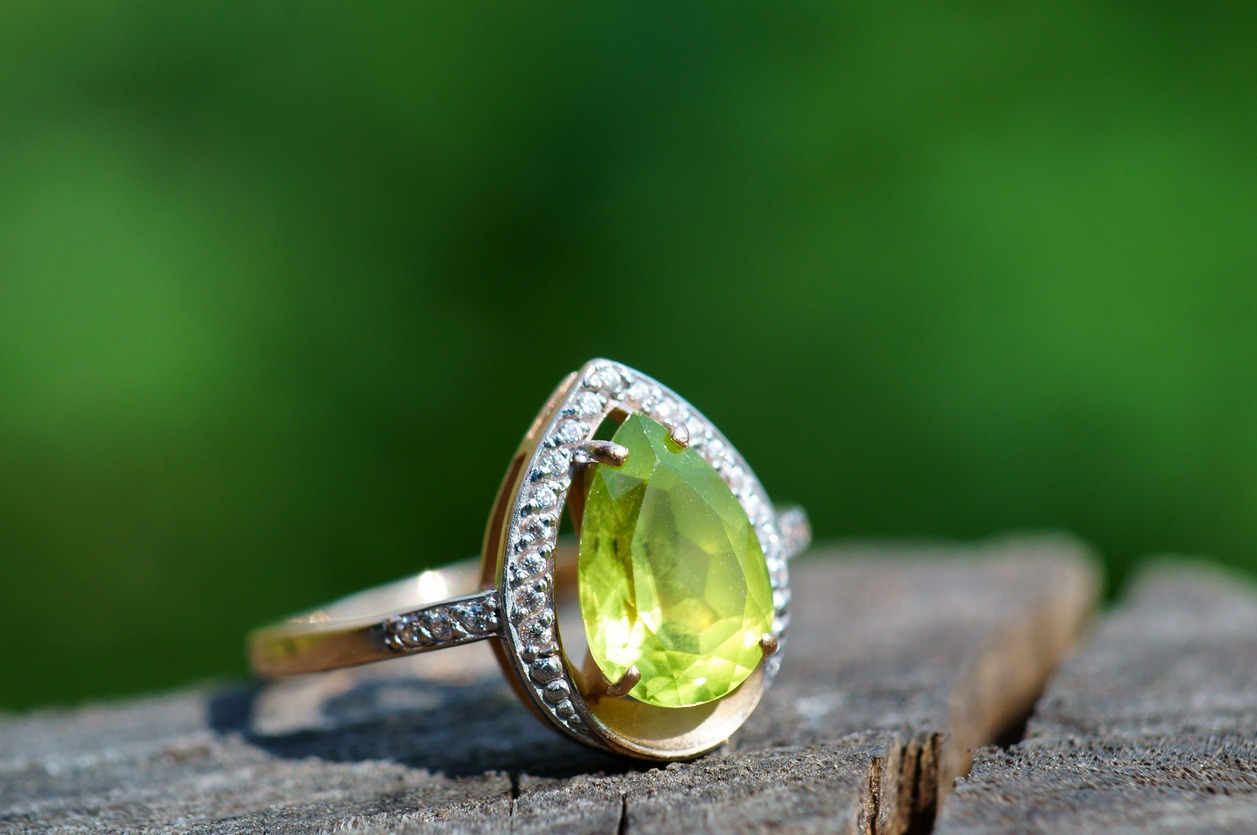Peridot is a stone adored and coveted by many connoisseurs because of its breathtaking and energizing olive green hue. The alluring color of the captivating and alluring gem gives all jewelry designs an almost animated appearance. It is available in a wide range of cuts, shapes, and sizes and is prized for its exceptional beauty.
Find out more as we talk about Peridot and its various uses in jewelry in this article.
What is a Peridot?
The word “Peridot” comes from the Arabic “faridat,” which means “gem.” It is a gem variety of a mineral group known as “olivine.” Now, the latter is a green rock-forming mineral found mainly in dark-colored igneous rocks and is thought to be the most abundant mineral in the mantle.
Peridot comes in various shades of green and yellow-green. As idiochromatic gems, Peridots get their characteristic green color from iron, an essential element of their chemical structure. In Peridot, ferrous iron (Fe2+) creates green, while ferric iron (Fe3+) creates yellow. Traces of chromium (Cr) in Peridots don’t cause a particular hue but may make the green color brighter.
Durability
It ranges from about 6.5 to 7 on the Mohs hardness scale. Peridot is fairly dense, with a specific gravity (the weight of the crystal compared to the weight of an equal volume of water) ranging from about 3.27 to 3.37. It is therefore relatively simpler to scratch, crack, or even shatter it.
Peridot and its Brief History
The use of Peridot goes back several thousand years. Ancient papyri record the mining of these stones as early as 1500 BC. The Egyptians enslaved the people of Topazo Island (now Zabargad or St. John’s Island) in the Red Sea and forced them to mine Peridot for use in ornaments and jewelry. In ancient times, these stones were used for carved talismans. Island inhabitants were forced to collect the gems for the Pharaoh’s treasury.
Some historians believe that Cleopatra’s famous emerald collection might actually have been Peridot. It has long been associated with wisdom and also as an aphrodisiac, so Cleopatra may have included the gemstone in her treasure trove as a reward for her lovers.
In the Middle Ages, Europeans brought Peridot stones back from the Crusades to decorate church plates and robes. They are also known to the ancient Hebrews and is listed both as one of the stones used by Aaron and in the text of the apocalypse (Revelations).
Before a coup d’état in 1962, which left the country a socialist totalitarian state controlled by its army, Burma was a thriving Peridot producer, principally in its North Central Mogok district. The only Burmese Peridot available now is decent, but far from great, yet the price is a hundred times that of Burma’s best before the country was shut off from the world.
What is Peridot used for?
For defense against challenges and negativity, many people use Peridot. It is frequently used to bolster and cleanse both the physical and energetic bodies. Peridot is thought to be a very happy, warm, and people-friendly stone that can help to calm jealousy and resentment as well as promote open-heartedness. Additionally, it is a stone of gratitude and abundance, and it can assist us in recognizing and inviting abundance in our lives—both material and spiritual. When it comes to identifying patterns that have been creating obstacles, Peridot can also be useful in assisting you in doing so. Peridot can also assist you in developing a greater trust in your inner voice and a decreased reliance on outside guidance.
Peridot and Jewelry
August has several birthstones, but the most well-known is Peridot. This beautiful green gemstone comes in a range of hues, from yellow-green to deep green, and lends itself to classic, stone-focused jewelry as well as accents with other stones and colors. Today’s designers feature Peridot in gorgeous pieces, ranging from statement necklaces and elegant pendants to nature-inspired earrings, bracelets, and rings.
The value of a Peridot entirely depends on its color and size. The higher-priced specimens of this stone are usually noted to be bigger in size, and they also have a darker and richer color. The average price of a Peridot is between $50 and $80 USD for a stone weighing one carat. The most expensive larger-than-1-carat Peridots are of the highest quality and range in price from $400 to 450 USD.
Where are they found?
Basalt (an igneous rock that formed from the lava that volcanoes erupted) flows and limestones are where most of the Peridot in the world is found. Meanwhile, much of the world’s commercial-quality Peridot is mined at the San Carlos Reservation in Arizona. Other countries with Peridot deposits include China, Vietnam, Myanmar, Pakistan, Norway, and New Mexico in the United States.
How to spot a real Peridot
Holding your stone up to the light is the best way to determine whether it is real or not. It is real if it results in double refraction. However, if it only reflects one light beam, it’s likely glass or a less expensive replica of the gem that you’re holding.
Fun Facts about Peridots
- Peridot is the birthstone for August and the 15th anniversary gemstone.
- One famous 200-carat Peridot gem that adorns the shrine of the Three Holy Kings in the cathedral of Cologne was thought to be an emerald for centuries before it was finally determined to be Peridot in the latter part of the 20th century.
- Peridot is the national gem of Egypt.
- Ancient Egyptians knew it as “the gem of the sun.”
- Peridot embodies many qualities of the wood element, and there are many ways to work with this stone in feng shui.
- It has been referred to as “Evening Emerald.”
Conclusion
Given its unique and alluring color, Peridot can truly be one of the new additions to your jewelry collection. It can accompany your other jewelry accessories and accentuate your other gem pieces.


